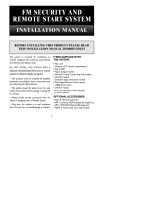Page is loading ...

VEHICLE SECURITY SYSTEM
WITH REMOTE START & NETWORK INTERFACE
BEFORE INSTALLING THIS PRODUCT PLEASE READ
THIS INSTALLATION MANUAL THOROUGHLY!!
INSTALLATION MANUAL
1
Before You Begin
This system is intended for installation on vehi-
cles equipped with automatic transmissions and
electronic fuel injection only! DO NOT INSTALL
THIS SYSTEM INTO A MANUAL TRANSMIS-
SION VEHICLE AS IT COULD RESULT IN SERI-
OUS INJURY OR DEATH.
• This product must be installed by qualified
personnel according to these instructions and
and observing all safety features.
• Verify that the vehicle is equipped with elec-
tronic fuel injection and automatic transmis-
sion.
• Check to see if the vehicle is equipped with
any type of factory security system.
• Check to see if there is a pin switch for the
hood, if not one must be installed.
• Verify that the vehicle starts and idles prop-
erly before starting the installation.
• Always use a multi-meter when verifying
vehicle wiring.
•Before mounting the product, verify with the
customer the desired location for the valet
switch and LED.
• Set the Polarity Jumper inside the main unit
first. (see Jumper Settings)
Installation Instructions
Mounting System Module
Mount the system module under the dash
where it will be difficult for a potential thief to
locate the module, and away from moving parts
such as brake pedals, etc. Mount the extended
range receiver on the windshield in a location
that will not obscure the driver’s view.
Mounting Siren
Mount the siren in a suitable place under the
hood, away from hot and moving engine parts
such as manifolds, fan belts, etc. Make sure the
siren cannot be accessed from underneath the
vehicle or through the grill. Face the siren down
so that water cannot accumulate inside the
siren bell. Protect wires running through the
firewall using either tape or split loom tubing. If
a new hole is needed, protect the wire from
chaffing by installing a proper size grommet.
Mounting Shock Sensor
Secure the shock sensor to the steering col-
umn, thick wire harness or a dash brace, using a
wire tie. Make sure that the adjustment screw is
accessible for later testing and adjustment.

2
High-Current Wire Connections:
• RED WIRE #1 -Main power input; using the
supplied inline fuse holder, connect directly to
the vehicle’s battery or alternate power source
with a minimum 30 Amp supply.
• RED WIRE #2 - Secondary power input; using
the supplied inline fuse holder, connect directly
to the vehicle’s battery or alternate power
source with a minimum 30 Amp supply.
Note: If not connecting directly to the vehicle’s
battery, it is recommended to use separate
power sources (minimum 30 Amp each) for each
red power wire.
• BROWN WIRE - Second ignition output;
connect to the wire that switches +12V and
does not drop out during cranking. This wire
may be optionally programmed for use as a sec-
ond accessory wire or second starter wire. (see
Programmable Features)
• ORANGE WIRE - Main accessory output;
+12V output to heater and/or air conditioning
system. For cars with more than one accessory
wire add a relay(s) to power the extra accesso-
ry wire(s) or program the BROWN wire for
second accessory.
• YELLOW WIRE - Main ignition output;
connect to the main ignition wire that switches
+12 V and does not drop out during cranking.
• VIOLET WIRE - Starter output; connect to the
vehicle’s starter wire.
Main Harness:
• GREEN/WHITE WIRE - Brake switch input
wire. Connect this wire to the brake switch wire
that provides +12V when the brake pedal is
pressed. This is a safety input and must be
connected on all installations.
• BLACK/GRAY WIRE - Tachometer input. If
the Smart Start feature fails to start properly,
connect the BLACK/GRAY wire directly to the
vehicle’s tach wire or negative fuel injector wire,
and program Step #20 to Tach Start.
• WHITE/RED WIRE - Auxiliary 2 output (-)
500mA. Connect to a relay or module for an
optional feature such as power window activa-
tion or remote start, etc. This output may be
programmed for momentary, timed, or latched
operation.
• BLACK/WHITE WIRE - Dome Light output
(-) 500mA. Connect to a relay to activate the
vehicle’s dome light. NOTE: The dome light
relay’s output is usually connected to the same
wire used for the door trigger input (See
GREEN and VIOLET door trigger wires).
• YELLOW WIRE - +12V Ignition input.
Connect to a main ignition wire at the ignition
switch harness.This wire shows +12V when the
ignition is on and while cranking. The voltage
must not drop when the car is starting.
• BLUE/YELLOW WIRE - Glow Plug Light
input (+). For diesel engine vehicles connect to
the glow plug wire in the instrument cluster
that shows +12V when the the glow plug (wait-
to-start) light is on, then shows ground when
the light turns off. For vehicle’s equipped with
a positive glow plug wire (shows ground when
the wait-to-start light is on) a relay is required.
(see Relay Diagrams)
• BLUE/WHITE WIRE - Passenger Unlock
output (-) 500mA. Connect to an optional relay
to unlock the passenger doors when the system
is configured for Driver Priority Unlocking.
• BLUE/ORANGE WIRE - Ground When
Running Output (-). This wire provides a ground
when the remote start is engaged to activate an
optional factory security bypass module.
• BLACK WIRE - Ground input (-). Connect to
a solid chassis ground that is clean and free of
paint or dirt.

3
• RED WIRE - +12V Battery input #3. Connect
the red fused wire on the main harness to a
constant +12V source. This wire is the power
input for the module.
• VIOLET WIRE - Positive door trigger (+).
Connect to the door switch circuit wire that
shows +12V when the door is open. This type
of door circuit is usually found on Ford vehicles.
• GREEN WIRE - Negative door trigger (-).
Connect to the door switch circuit wire that
shows ground when the door is open.
• WHITE/BLACK WIRE - Hood trigger (-).
Connect this wire to an optional hood pin
switch.The switch must provide a ground when
the switch is opened.
• ORANGE WIRE - Armed output (-) 500mA.
Connect to a relay for optional starter defeat
and anti-grind protection. (See Relay Diagrams).
• VIOLET/WHITE WIRE - Factory Disarm
output (-). Connect to the wire that requires a
ground pulse to disarm the factory alarm. The
VIOLET/WHITE wire provides a ground pulse
when the remote transmitter is used to unlock
the doors or start the vehicle.
• WHITE/VIOLET WIRE - Factory Arm out-
put (-). Connect to the wire that requires a
ground pulse to arm the factory alarm. The
WHITE/VIOLET wire provides a ground pulse
when the remote transmitter is used to lock the
doors or when the remote start shuts down.
• BROWN WIRE - Siren wire output (+) 3A.
Connect to the siren’s red wire. Connect the
siren’s black wire to ground.
• GRAY WIRE - Auxiliary 1 output (-) 500mA.
Connect to a relay for optional features such as
trunk release, etc. This output is programmable
for momentary, timed, or latched operation.
• WHITE WIRE - Parking Light output (+/-)
10A relay. Connect to the vehicle’s parking light
wire. If the vehicle’s parking light circuit exceeds
10 Amps a relay is required. For vehicle’s with
independent left and right parking light circuits,
the parking light wires must be connected using
diodes to keep the circuits separate. NOTE: Do
not connect the WHITE wire to the vehicle’s
headlight circuit.
• BROWN/WHITE WIRE - Horn output (-)
500mA. Connect to an optional relay to activate
the vehicle’s horn when the alarm is triggered.
This wire is also programmable for use as a 3rd
ignition output if necessary.
Plug in Connectors
4-Pin White Connector: Plug-in connector
port for dual stage shock sensor.
2-Pin Blue Connector: Plug-in connector port
for program/service switch. Mount program
switch in an area that is easily accessible from the
driver’s position.
2-Pin Red Connector: Plug-in connector port
for LED. Mount LED in an area where it may be
easily seen from either side of the vehicle.
3-Pin White Door Lock Connector: Plug-in
connector port for door lock harness or option-
al door lock relay module (PDLM-3).
• BLUE WIRE - negative unlock output (-)
500mA.
• RED WIRE - Relay trigger only (+) 300mA.
Low current output for relay modules, or invert-
ers. Do NOTuse as a power source for door
lock relays.
• GREEN WIRE - negative lock output (-)
500mA.
3-Pin White Connector: The plug-in network
connector port is on the side of the main mod-
ule. This network port may be used with the
optional personal computer interface for diag-
nostics, software customization and expanded
programming options. The network also offers
connection to optional accessories. For LCD
FM 2-way systems, plug the FM module into this
port.

4
Programmable Features
Step Function Button 1 Button 2 Button 3
1. Arming Mode Active Passive
2. Auto Rearm Off On
3. Normal/Silent Arming Normal Silent
4. Ignition Locking On Off Override Code Set
5. Ignition Unlocking All Doors Driver only Off
6. Door Unlock Pulse Single Double
7. Door Lock Pulse Width 1 second 3 seconds
8. Passive Locking Off On
9. Entry Delay with Passive Arming Off On
10. Bad Zone Report 5 seconds Off
11. Auxiliary 2 Auto Activate on Arming Off On
12. Auxiliary 1 Output Momentary 10 seconds Timed Latched
13. Auxiliary 2 Output Momentary 10 seconds Timed Latched
14. Trunk Disarm Feature Off On
15. Remote Start in Valet Mode (optional) Enabled Disabled
16. Lock With Remote Start On Off
17. Lock With Remote Shutdown On Off
18. Engine Run Time 12 minutes 24 minutes
19. Cold Temperature Starting Every 2 hours Every hour
20. Engine Start Sense Smart Start Tach Start
21. Engine Programming Learn RPM Gas Engine Diesel Engine
22. FM Module Program (optional) Learn Module Learn FM Transmitter
23. Ignition 2 Relay Programming Ignition 2 Accessory 2 Starter 2
24. Horn Output Horn Output Ignition 3 Output
Entering Programming
To enter System Programming:
1. Turn on ignition.
2. Within 5 seconds, press valet switch 5
times.
• The siren will chirp 3 times, indicating
that you have entered Programming.
3. Press the valet switch the number times
equal to the Feature you want to change.
• The siren will chirp each time the valet
switch is pressed.
4. Within 5 seconds, press the transmitter
button corresponding to the desired oper-
ating mode for that Feature.
• The siren will chirp to indicate the set-
ting.
One chirp = Button 1
Two chirps = Button 2
Three chirps = Button 3
5. Repeat steps 3 and 4 to change additional
features.
6. Turn off ignition to save changes.
Note: The optional FM transmitter may not be
used for feature programming.

5
Programmable Features
1. Arming Mode. Select between manual arm-
ing (Active) or automatic arming (Passive).
2. Auto Rearm.Automatically rearms the sys-
tem in case of accidental disarming.The system
must be armed for at least 10 seconds before
disarming, and the hood/trunk must not be
opened or Auto Rearm will be bypassed.
3. Arming Chirps. Select Normal or Silent
Arming.
4. Ignition Locking / Override Code Set.
Automatically locks the doors when the igni-
tion is turned on.The system will not lock the
doors if any door is open when the ignition is
turned on. Pressing Button 3 during this step
enters the Override Code Set mode. Press the
valet switch the desired number of times from
1-15 to set the code.
5. Ignition Unlocking. Automatically unlocks
the doors when the ignition is turned off. Select
from all door unlock, driver's door only unlock,
or no unlock. (Note: Driver’s door only unlock
requires wiring the system for Passenger
Unlock. see Two Step Unlocking Diagrams.)
6. Door Unlock Pulse - Single/Double. Selects
between a single pulse or a double pulse door
unlock output.
7. Door Lock Pulse Width. Selects between a
1-second and a 3-second output for vehicles
equipped with vacuum door locking systems.
8. Passive Locking. Selects whether or not the
system will automatically lock the doors with
Auto Rearm and Passive Arming.
9. Door Entry Delay with Passive Arming.
When selected, the door input trigger will be
delayed for 15 seconds, allowing access to the
emergency override switch. Only delays when
the system is armed passively.
10. Bad Zone Report. Siren will chirp 3 times if
any zone remains open 5 seconds after arming.
If vehicle has delayed dome light, program this
feature to OFF.
11. Auxiliary 2 Auto Activate on Arming.When
selected, the Auxiliary 2 output will pulse upon
system arming to activate accessory items
when the system is armed.
12. Auxiliary Function I - Selectable for
Momentary,Timed, or Latched operation.
When Momentary operation is selected, the
system will provide an output for as long as the
Transmitter button is held.
When Latched operation is selected, the system
will provide an output that turns on when the
transmitter button is pressed and turns off
when the transmitter button is pressed again.
When Timed operation is selected, the system
will provide an output that turns on for 10 sec-
onds each time the transmitter button is
pressed. If the button is pressed again during
the 10 seconds, the output will turn off.
13. Auxiliary Function 2 - Selectable for
Momentary,Timed, or Latched operation.
14. Trunk Disarm Feature. When selected,
activating the Auxiliary 1 function to open the
trunk will automatically disarm the system.
15. Remote Start in Valet Mode. Determines if
the remote start feature will operate when the
alarm is set for valet mode.
16. Lock with Remote Start. Automatically
locks the doors after successfully remote start-
ing.
17. Lock with Remote Shutdown.
Automatically locks the doors 5 seconds after
the remote start is shut down.
18. Engine Run Time. Selects between 12 and
24 minute run cycle.

6
19. Cold Temperature Starting. Allows the
vehicle to automatically start and run every 2
hours or every hour for severe cold weather.
20. Engine Start Sense. Selects between Smart
Start for tachless operation, or Tach Start for
actual RPM monitored starting. (see Step #21)
21. Engine Programming. Pressing transmitter
button I "learns" the RPM. For diesel vehicles,
after learning Tach signal enter step #21 again
and set for diesel by pressing button 3.
22. FM Transmitter Module. Pressing button 1
learns the add-on FM module ID so the FM trans-
mitter can operate the system. Pressing button 2
learns the FM transmitter. After pressing button 2
on the AM remote, press transmitter button 1 on
each FM remote (max 2).
23. Ignition 2 Relay Programming. Selects
between second ignition, second accessory, or
second starter output operation for heavy
gauge BROWN wire.
24. Horn Output. Selects between horn output
or ignition 3 output for the horn wire.
Engine Programming for Remote Start
In order for the system to properly start and
run the vehicle, the unit must be able to deter-
mine if the engine is cranking or if the engine
is actually running.This system is equipped with
two means of detecting the engine’s run status:
Smart Start and Tach Start.
The Smart Start feature detects the engine’s
run status using specially designed software
that interprets certain characteristics of the
engine, and does not require a connection to
the vehicle’s tachometer wire. This feature
allows a faster installation, but may not be com-
patible with all vehicles, or under extreme tem-
peratures.
The Tach Start feature requires connection
the the vehicle’s tachometer wire, or an injec-
tor wire if the tach wire is not available. The
Tach Start feature provides reliable operation
with virtually any vehicle and in severe temper-
ature extremes. When the Tach Start feature is
selected, the vehicle’s tach signal must be
“learned” through system programming. (see
below)
To Program the Tach Start feature:
1. Enter System Programming. (see Entering
Programming)
2. Program Step #20 to Tach Start using trans-
mitter button 2.
3. Start the vehicle with the key.
4. With the engine running, immediately re-
enter programming, and go to Step #21.
5. Press transmitter button 1 to learn the vehi-
cle’s tach signal.
• The siren will chirp and the LED will flash
once if the tach was learned.
• The siren will chirp and the LED will flash
5 times if the tach was not learned.
6. Turn off ignition to save settings.
The default setting for the engine mode is Gas
Engine. For diesel vehicles, the engine type for
Step #21 must be set to Diesel Engine. When
programmed for diesel engines, the BLUE/YEL-
LOW wire (glow plug input) is monitored to
make sure the glow plugs have warmed up
before the engine begins cranking. If the glow
plug wire is not connected, the unit has a built-
in timer that waits 15 seconds before cranking
the starter.

7
Complete Default Reset
Following this procedure will set all User and
Installer Programming Parameters to factory
default settings.
1. Enter System Programming.
2. Press Transmitter Button 3.
• The siren will chirp 6 times indicating the
reset signal was received.
• All Programming options are now set to
factory default settings.
3. Turn ignition off.
Test System and Adjust Shock Sensor
Arm, disarm, and start the system, checking that
the siren and parking lights are functioning nor-
mally. Make sure that the programmed features
are performing correctly, ie.: ignition locks, pas-
sive arming, passive locks, etc.
Test the doors and hood/trunk inputs (make
sure all doors trigger the system.
Adjust the shock sensor. (see Real-time Sensor
Adjustment Mode)
Arm the system and disarm it with the ignition
and valet switch.
If programmed to passively arm make sure that
the system arms properly.
Tie up wire harness, and replace any under dash
panels.
Make sure the customer has physical knowledge
of the location of the valet/override switch.
Real-time Sensor Adjustment Mode
This mode allows active testing of the shock sen-
sor and optional sensor input making adjust-
ments without arming the alarm. NOTE: Arm
and Disarm chirps must enabled for proper
operation. Sensor Adjustment Mode does not
operate with the optional FM transmitter.
To enter Sensor Adjustment mode:
1. Turn the ignition on.
2. Press the Shift Button (Button 5) 3 times,
then Button 3.
• The siren will chirp 4 times, indicating that
the sensor is ready to be tested.
3. Test the sensitivity. The siren will chirp to
indicate a sensor is triggered.
• One chirp indicates the shock sensor.
• Two chirps indicates the warn away.
• Three chirps indicates the optional sensor.
4. To make shock sensor adjustments:
• Turn the adjustment screw on the sensor
clockwise to increase the sensitivity.
• Turn the adjustment screw on the sensor
counter clockwise to decrease the sensi-
tivity.
5. Turn off the ignition when the desired sensi-
tivity level is reached.
Adding Transmitters
To add a new transmitter to the system have the
desired transmitters ready and follow the Code
Learning sequence.
To enter Code Learning Mode:
1. Turn the ignition on, off, on, off and leave on.
• The siren will chirp.
2. Press the Override switch.
• The status LED will turn on red.
• The siren will chirp.
3. Press the Lock Button on the transmitter.
• The siren will chirp once.
4. Press Lock Button on the transmitter again.
• The siren will chirp twice.
5. Repeat steps 3 and 4 for each additional
transmitter.
6. Turn off the ignition.
• The siren will chirp 3 times.

8
Bypassing Factory Theft Deterrent
Systems
Many newer vehicles are now factory-equipped
with anti-theft systems that use either a resistor
coded key or a passive transponder that disables
the fuel system unless a properly coded key is
inserted into the ignition cylinder. To integrate a
remote starter into these vehicles, you must
determine which type of factory anti-theft sys-
tem is equipped, then use the proper bypass
module for that system.
General Motors Anti-theft Systems:
Many late-model GM vehicles are equipped with
one of three basic anti-theft systems; Passkey,
Passlock, and Passkey 3. Standard Passkey
systems are easily identified by the resistor chip
visible on the shaft of the key. Passlock systems
do not rely on a resistor equipped key. Instead
they use a resistance code generated when the
key is turned in the ignition cylinder. Both of
these systems have an anti-theft indicator in the
instrument cluster. To properly interface into
these systems and retain full functionality of the
factory anti-theft system, VATS/PASSLOCK
bypass module must be installed.
The Passkey 3 system, which is found on GM
vehicles 1999 and newer, is a transponder based
system described below.
Passive Transponder Systems:
Passive transponder systems have become the
most popular anti-theft system among vehicle
manufacturers (Ford, Honda, BMW, Toyota,
Nissan and others). This system requires use of
a tiny passive transmitter housed in the base of
the key. This device activates when placed close
to the vehicle’s ignition switch. The starter will
usually crank but the fuel system will be disabled,
not allowing the vehicle to run, if the transpon-
der is not detected. To properly interface
into transponder systems, a transponder
bypass module must be installed. These
modules allow full functionality of the factory
anti-theft system and usually require the use of a
spare key.

9
HORN HONK DIAGRAMS
TRUNK RELEASE DIAGRAM
RELAY WIRING DIAGRAMS
STARTER DISABLE / ANTI-GRIND
OPTIONAL HEADLIGHT ACTIVATION
Program the Auxiliary 2 output for timed operation
and the headlights will turn on with Aux 2 for the pre-
set timer duration then automatically turn off.
Program the Auxiliary 2 output for latched operation
and the headlights will turn on with Aux 2 and remain
on until the Auxiliary 2 function is pressed again.
NEGATIVE GLOW PLUG
DOME LIGHT DIAGRAMS

10
NEGATIVE PULSE LOCK SYSTEM POSITIVE PULSE LOCK SYSTEM
ADDING ACTUATORS VACUUM LOCK SYSTEM
DOOR LOCK WIRING DIAGRAMS
REVERSE POLARITY LOCK SYSTEM

11
TWO-STEP UNLOCK
NEGATIVE PULSE
TWO-STEP UNLOCK
POSITIVE PULSE
TWO-STEP UNLOCK
REVERSE POLARITY
TWO-STEP UNLOCK
ADDING ACTUATORS
OPTIONAL TWO-STEP UNLOCK WIRING DIAGRAMS

12
TROUBLESHOOTING
Problem
Alarm does not operate.
Alarm will not Passively Arm.
Alarm will not enter Code
Learning Mode.
Alarm chirps 4 times 5 sec-
onds after system is Armed.
Parking lights do not flash.
Door locks do not lock or
unlock correctly, or action is
reversed
Illuminated Entry does not
activate on upon disarm.
Probable Cause
Alarm in Valet Mode; Ignition
input has voltage on it; Missing
+12V or ground.
Unit is not programmed for
Passive Arming, wrong polarity
door input wire, Yellow igni-
tion input has 12V+ on it.
Ignition was not left in the on
position after turning it on &
off three times; Sequence not
performed rapidly enough (5
sec.); Valet/Override Switch is
defective or not plugged in.
Factory Dome light Delay is
longer than 5 seconds; Door
open or defective pin switch;
Shock sensor is not properly
adjusted or defective.
Wrong wire connected,
Wrong polarity selected, or
RED Wire #1 not connected
to battery power.
Defective GREEN or BLUE
wire in door lock connector
plug, GREEN and BLUE wires
reversed, or wrong door lock
wiring diagram used.
External relay required, or
Wrong polarity wired for
relay.
Suggested Correction
Take alarm out of Valet mode;
Turn key off and verify yellow
wire is connected to correct
ignition wire; Check +12V and
ground connections.
Program step #1 for Passive
Arming; Correct door switch
polarity; Change ignition input
wire; Make sure alarm is not in
Valet.
Leave ignition in on position;
Repeat procedure quicker;
Replace valet switch.
If dome light delay is longer
than 5 seconds program Step
#10 to OFF; Replace defective
pin switch; Adjust or replace
shock sensor.
Connect WHITE wire to
proper wire, Reverse jumper
polarity (see Jumper Settings),
Connect RED wire #1 to +12V.
Check GREEN and BLUE wires
on door lock connector plug;
Verify vehicle’s type of door
lock system; Reverse wiring to
door relays.
Add relay (see Relay Wiring
Diagrams; Reverse relay polar-
ity.

13
TROUBLESHOOTING CONTINUED
Problem
Range is poor.
Vehicle will not remote start
and parking lights flash.
Vehicle cranks and begins to
run, then shuts off.
Vehicle cranks and begins to
run, then shuts off.
Keyless entry does not oper-
ate with remote.
Ignition triggered door lock
feature does not operate.
Car horn honks when system
disarmed and door is opened.
Car will not start and alarm
does not function properly.
Diesel vehicle cranks at incor-
rect time (before wait-to-start
light turns off or long after
light turns off,.
Probable Cause
Antenna wire is grounded;
Module is picking up interfer-
ence from vehicle’s electrical
system.
Safety inputs are triggered. 3
flashes= hood, 4=brake.
Smart Start is not compatible
with this vehicle;Vehicle’s tach
signal is not learned.
Vehicle has a factory theft
deterrent system that pre-
vents starting w/o key in igni-
tion.
Wrong door lock polarity;
Wrong lock wires connected.
Yellow wire shows +12V;
Door is open; Door trigger
input wrong polarity.
Vehicle’s factory security sys-
tem needs to be disarmed.
Vehicle battery dead or drops
below 9 volts when trying to
start the vehicle.
Glow plug wire not connect-
ed; Glow plug wire connected
to wrong wire; Wrong glow
plug wire polarity.
Suggested Correction
Make sure antenna is not con-
nected to ground; Relocate
module or route antenna away
from computer modules.
Check Brake Switch Input (+)
or Hood Input (-).
Connect the BLACK/GRAY
wire, and program the unit to
learn the vehicle’s tach signal.
See Bypassing Factory Theft
Deterrent Systems.
See door lock diagram; Verify
vehicle lock/unlock wires.
Connect yellow wire to proper
ignition wire; Close door;
Change door trigger polarity.
Locate the disarm wire (usual-
ly located in driver’s kick panel)
and connect VIOLET/WHITE
wire to disarm factory system.
Charge or replace battery.
Connect BLUE/YELLOW wire
to glow plug wire; Connect to
correct glow plug wire in vehi-
cle; Check glow plug wire
polarity and use a relay to
change (see Relay Diagrams).

14
LED INDICATIONS
On Solid = Valet Mode
Slow Flash = System Armed
Rapid Flash = Passive Arming
2 Flashes = Shock Sensor
4 Flashes = Door Trigger
5 Flashes = Hood/Trunk
LED TAMPER ALERT INDI-
CATIONS
1 Flash = Optional Sensor
2 Flashes = Shock Sensor
4 Flashes = Door Trigger
5 Flashes = Hood/Trunk
PARKING LIGHTS FUNC-
TIONS
Flash 1x = Armed
Flash 2x = Disarmed
Flash 3x = Open Zone
Indication (after arming)
Flash 3x after Disarm =
Tamper Alert
INSTALLATION NOTES

15
INSTALLATION NOTES

16
WIRING DIAGRAM
JUMPER SETTINGS
The output polarity for the built-in parking light relay is deter-
mined by the placement of the jumper on the 3 pins in front of
the relay. The default settings is illustrated on the left.
Jumper on Center Pin and Left Pin = Positive Output
Jumper on Center Pin and Right Pin = Negative Output
© 2002, DLC, INC. 64-6150/7150, 12/02 Rev. 2
/








